If you want to know about the water supply requirements for building or water supply system in tall building or principles of water supply, please click the link.
Rainwater harvesting is the process of collecting and storing rainwater for later use. This can be done through various methods, such as collecting rainwater from rooftops, surfaces, and catchments like ponds or wells.
- Rainwater is an ideal source which can be conserved and used in a useful manner by the people.
- The amount of rainfall available varies from region to region.
- Each area has to develop its own method and system to conserve, store and use it to suit its requirement and local conditions.
- There are several methods by which rainwater can be stored, used and conserved.
- Each system depends on the amount of precipitation, the period in which the rainfall occurs in a year and the physical infrastructure, for example space available to store the water, etc.
- There are several techniques available for catching and storing the rainwater.
- Most of the techniques are applicable for large open areas, farms, sloping grounds, etc, with a low population base.
- Two major systems that are ideal for urban and semi-urban developed areas are:
- Artificial ground water recharge, and
- Roof top rainwater harvesting.
NOTE – Type and number of recharge pits and roof top rainwater harvesting capacity shall be provided as per the local / state byelaws.
1) Artificial ground water recharge
- With increase in the impermeable surfaces in modern built-up areas, there is gross reduction in the original catchment area.
- This prevents the natural percolation that would have recharged the area in the normal course if the ground was in its natural condition, for example a farm, open ground, forest, etc.
- This results in a large quantity of water, normally percolating into the ground, running off to the natural drains and into the rivers, causing increased runoff and flooding of downstream areas.
- It is therefore essential to catch the runoff and use it for augmentation of ground water reservoir by modifying the natural movement of surface water by recharging it by artificial means, for example construction of recharge structures. As shown in the figure below.
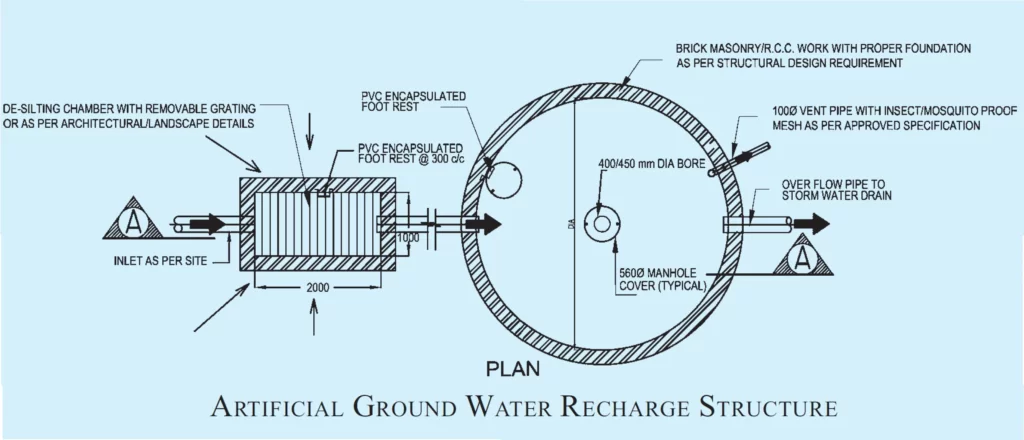
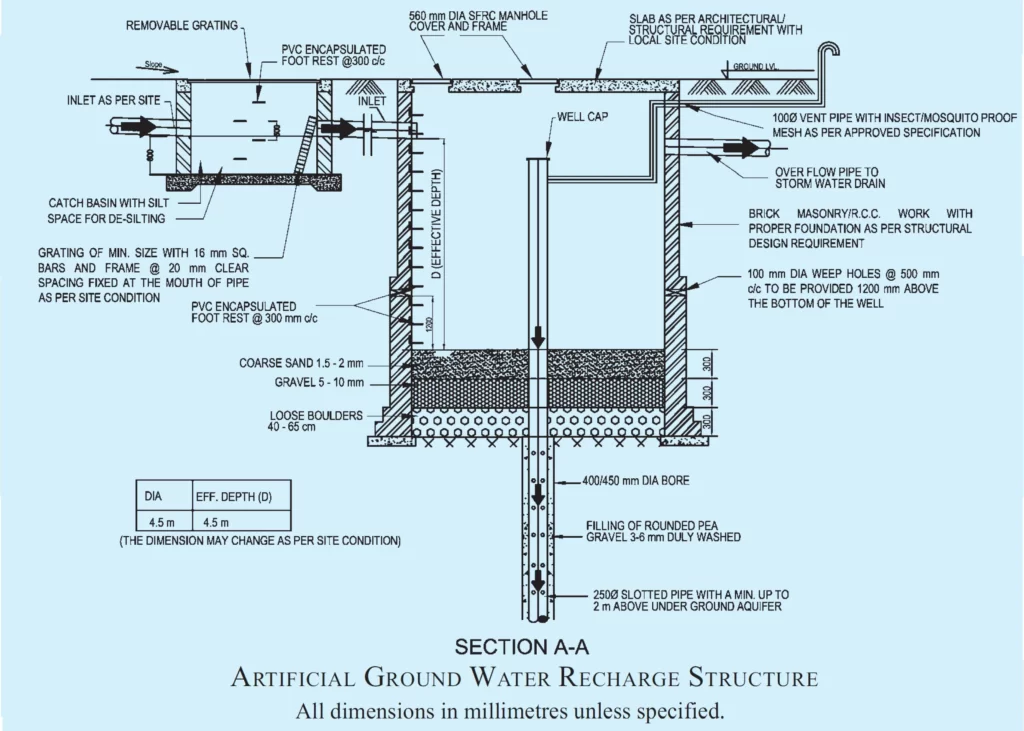
The main objectives achieved may be:
- Enhancement of sustainable yield in areas where over development and depletion of the aquifers.
- Conservation and storage of excess surface water in the aquifers.
- Improve the quality of the existing ground water through dilution.
- Remove bacteriological and suspended impurities during the surface water transition within the subsoil.
- Maintain the natural balance of the ground water and its usage as the rainwater is a renewable supply source.
A well-managed and controlled tapping of the aquifers will provide constant, dependable and safe water supply.
In planning and designing the ground water recharge structures, following should be taken into consideration:
- Annual rainfall (for estimating approximately rainwater recharge per year).
- Peak intensity and duration of each storm.
- Type of soil and subsoil conditions and their permeability factor.
- Ground slopes and run off which cannot be caught.
- Location of recharge structures and its overflow outfall.
- Rainwater measuring devices for finding the flow of water in the system.
NOTE – Rainwater harvesting with underground recharging will depend from region to region as per the climatic, topography, soil conditions and data about intensity of rainfall and retention time for calculating the capacity of recharge wells to be obtained from reference documents from the Authority.
2) Roof top rainwater harvesting
Harvesting in regular rainfall areas
- In areas having rainfall over a large period in a year, for example in hilly areas, coastal regions, etc constant and regular rainfall can be usefully harvested and stored in suitable water tanks.
- Water shall be collected through roof gutters and down take pipes.
- Provision should be made to divert the 1st rainfall after a dry spell so that ant dust, soot and leaves, etc, are drained away before the water is collected into the water tank.
- The capacity of the water tank should be enough for storing water required for consumption between two dry spells.
- The water tank shall be located in a well-protected area and shall not be exposed to any hazards of water contamination from any other sources.
- The water shall be chlorinated using chlorine tablets or solution to maintain a residual chlorine of approximately 1 mg/l.
- The tank shall have an overflow leading to natural water courses or to any additional tanks.
Harvesting in limited rainfall areas
- In areas with the rainfall limited during the monsoon period (usually from 15-90 days), roof top rainwater can be stored and used for non-potable purposes, after proper treatment, in the premises itself as mentioned above; excess water, if any, is best used for recharging the ground water.
- For individual properties and plots the roof top rainwater can be diverted to underground or above ground water storage tank(s), pretreated, stored and used for non-potable purposes.
- Excess water, if any, may be discharged to existing open or abandoned tube wells.
- In a well-planned building complex, a system should be laid out so that the runoff is collected in underground or above ground water storage tank(s), pretreated, stored, and used for non-potable purposes.
- Excess water, if any, shall be discharged in bore-wells as per designs specified by the Central Ground Water Board, Government of India.
3) Care to be taken in rainwater harvesting
Water conservation technique discussed above shall be constructed with due care taking following precautions.
- No sewage or waste water should be admitted into the system.
- No waste water from areas likely to have oil, grease or other pollutants should be connected to the system.
- Each structure/well shall have an inlet chamber with a silt trap to prevent any silt from finding its way into the subsoil water.
- The wells should be terminated at least 5 m above the natural static subsoil water at its highest level so that the incoming flow passes through the natural ground condition and prevent contamination hazards.
- No recharge structure or a well shall be used for drawing water for any purpose.
4) Siphonic drainage system
- It is an installation generally used for special situations such as roofs with large spans for structures like hangars, airport terminals, stadia and industrial sheds, where the number of down pipes has to be limited.
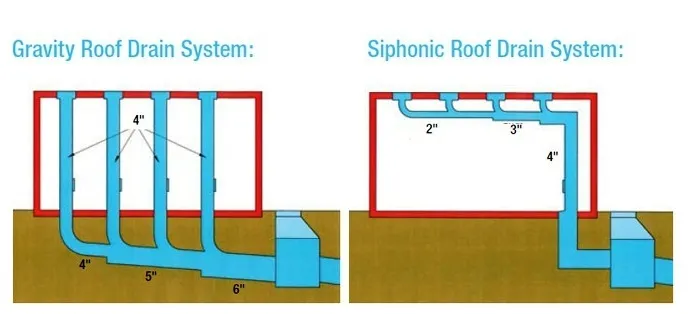
- These are designed for full flow of pipes and the roof outlets are different from conventional ones.
- Siphonic roof drainage systems are engineered on the concept of a full bore (a fill rate of 100 percent).
- This implies that rainwater flows at high speed through small diameter pipe work, at normally zero gradient.
- This siphonic effect is created by the (kinetic) energy derived from the hydraulic head, caused by the difference in height between the roof outlet and the discharge point in a building.
- Specialist roof outlets prevent air being sucked into the system.
- The engineering principle of siphonic roof drainage design is based on the Bernoulli’s energy equation for a steady flow of an incompressible fluid with constant density.
- In order to balance the equation, and to guarantee the required siphonic effect according to the rainfall intensity, the ideal pipe dimensions per flow path need to be determined.
- In case of syphon system, the outlets of drainage system prevent vortex formation, thereby preventing air from entering the pipeline ensuring the entire system is running at full flow as shown in the figure below.
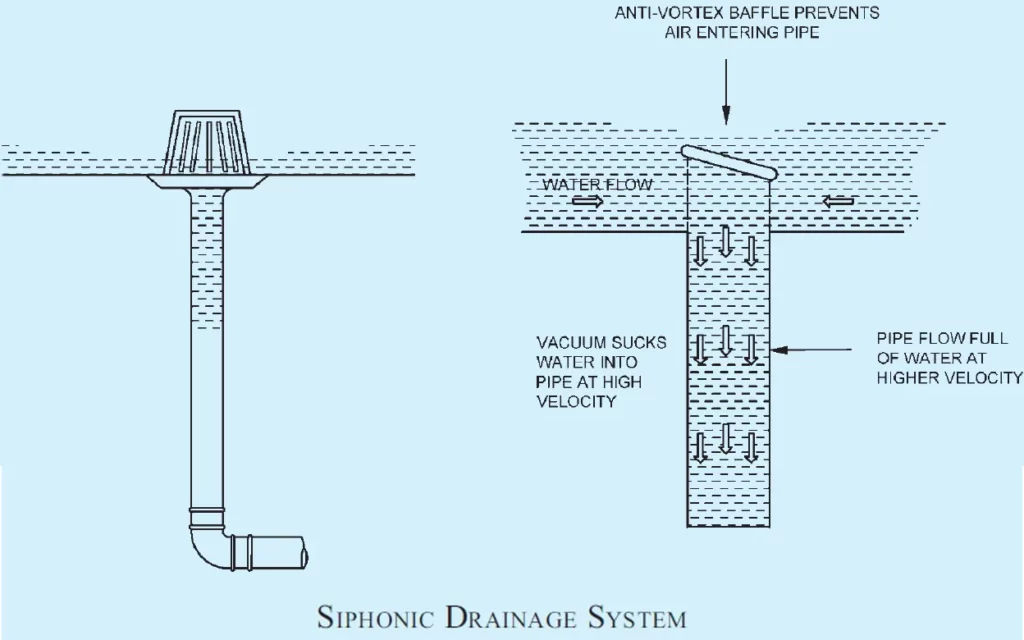
- It uses design that complies with Bernoulli’s principle where equal energy is created under positive and negative pressure.
5) Rainwater harvesting for plotted/group housing developments
- The rainwater harvesting methods adopted for plotted and group housing are through collection of rooftop rainwater and surface runoff harvesting.
- A network of storm water drains in the entire residential area is used for harvesting rooftop rainwater and surface runoff.
- Appropriate number of recharge wells measuring 1 m × 1 m × 2 m may be constructed in the storm water drain for facilitating groundwater recharge.
- The quality of runoff, which passes through the borewell installed inside the recharge well, is ensured through a filter bed of pebbles (see Figure below).


6) Other methods of rainwater harvesting
Creation of artificial reservoirs/lakes for utilization of available storm water
- This shall be based on estimation of amount of runoff volume based on rainfall data (for a period of 10 years) considering the percolation and evaporation losses and efforts to be made to collect all available runoff for proper utilization.

Water balancing methods
- This refers to optimum utilization of available water from different sources, namely ground water, recycled wastewater, storm water and municipal supply and its adoption would ensure that there is no wastage of water.
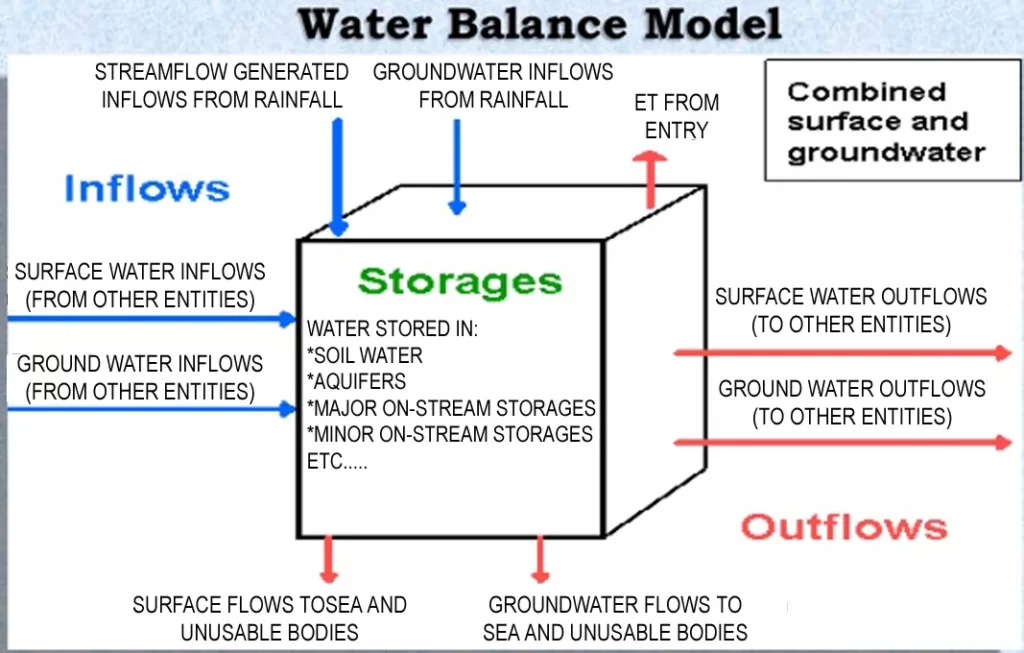
Overall, rainwater harvesting is an effective way to conserve water resources, reduce costs, and protect the environment.
The rainwater I harvest seems to be staining the lavatories. The discolour is black. There is no lime in the water. I have tried hydrogen peroxide as a possible cleaner to no effect. Any suggestions both for cleaning and filtering would be valued.